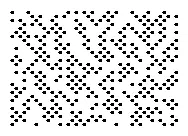DotCode
What is a DotCode?
A DotCode is a 2D barcode that was introduced in 2009 and was designed for use with high speed industrial printers. It doesn’t require continuous lines or precise spacing, which makes it a good choice for manufacturing environments where speed is essential.
DotCode is also known as a ‘Dot Matrix’ code because it is composed of dots arranged in a rectangular array. These ‘data dots’ are either square or circular and are positioned on a grid diagonal to the rectangle outline of the symbol.
It’s a very robust symbol that is well suited for high speed production and printing applications such as cigarette manufacturing, where it is commonly used to meet EU tobacco traceability regulations.
The DotCode language is published by AIM, one of the world’s leading authorities on automatic identification and data capture (AIDC) technologies. It was also recently adopted by global standards organization GS1 in their General Specifications update.
Unlike QR and Data Matrix codes, DotCodes are usually thin and rectangular in shape with no square pixels or Locator Pattern boxes.
A DotCode can contain as much or as little data as you want, as long as it is not too large. However, a DotCode is only readable when printed by high speed coding systems like inkjet or laser printers.
For example, a DotCode can tell you the manufacturer plant where the product was made and the size of the product, as well as other relevant information. In addition, a DotCode can include a ‘date’ code to indicate the week and year the product was manufactured.















 RFID Cage
RFID Cage
